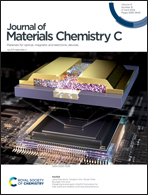Straddling SnSe2/SnS2 van der Waals tunneling heterostructures for high performance broadband photodetectors†
Abstract
Layered van der Waals 2D materials possess remarkable light–matter interaction properties and offer a broad range of tunable bandgaps through the facile fabrication of heterostructures, which have opened up numerous possibilities for applications in the field of optoelectronics. Previous research has indicated that type-I van der Waals heterostructures hold significant promise for photodetector applications. Nevertheless, the underlying tunneling mechanisms within type-I heterostructures have not been fully elucidated. In this study, a highly efficient photodiode based on a SnSe2/SnS2 type-I van der Waals heterostructure is successfully fabricated, which is further validated through density functional theory calculations that explored the interlayer band structure under the influence of electric fields. A unilateral depletion region is formed on SnS2, which effectively suppressed carrier recombination at the interface. The device exhibits an ultrahigh on/off ratio of approximately 107, primarily attributed to the depletion effect of SnS2 and the improved interface effect of h-BN. Additionally, the device demonstrates a remarkably high responsivity of 37.5 A W−1 and broadband detection width from ultraviolet to visible spectrum. These unique characteristics suggest that our findings could pave the way for the development of next-generation, highly efficient optoelectronic devices.



 Please wait while we load your content...
Please wait while we load your content...